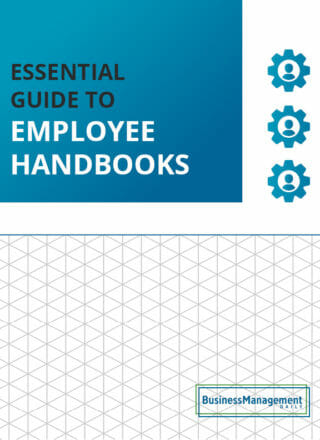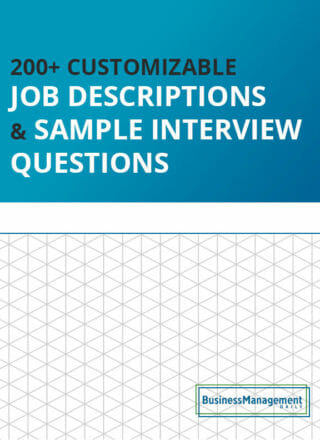How to discuss poor performance: Strategies for managers
 Updated 2/4/20
Updated 2/4/20
Ignoring an employee’s poor performance won’t make the problem go away; it’ll only make things worse.
If you’re apt to take the head-in-the-sand approach to employees’ job failings, you’re not alone: Only 31 percent of U.S. workers agree with the statement “My manager confronts poor performance,” according to a KEYGroup survey.
And companies that tolerate poor performance will drive away top performers who are unhappy working in such an environment.
Approach workers about their poor perfomance in a fair, problem-solving manner. When you confront such people in a tactful way, you’ll find that one of two things happens: They improve or they move.
Here are the rules and best practices on how to discuss poor performance with an employee.
Be specific about poor performance
If an employee has been consistently late, specify the number of times or amount of time. Avoid exaggerations, such as “You are totally unreliable.” Instead, say, “This is the third time in one week that you have been at least 10 minutes late.”
If this issue has been a problem in the past, remind the employee when you have pointed out the offense previously. Say, “I indicated to you last Tuesday that coming in late is not acceptable.”
Offer objective, concrete descriptions of the problem, not vague statements. Provide specific examples and dates, backed by documentation. Avoid words like “always” and “never”; they’re exaggerations and don’t usually reflect realistic frequency.
Focus on business reasons
Focus on the business reason for the corrective comments. Stay away from personality critiques. Be able to point to written employee goals and company guidelines that aren’t being met.
Always refocus the employee on the stated business reason for your comments. Example: “It’s important for you to be here at the designated time since customers rely on our immediate responsiveness when they have questions about their orders.”
If you need to correct something like inappropriate casual dress, reiterate the company guidelines. Don’t comment on the employee’s personal taste. Straying into areas that have nothing to do with workplace performance will result in a loss of credibility with that person. Stay focused on the employee’s poor performance and how it affects the company.
Give timely feedback
A common management mistake is to bombard employees with feedback at their appraisal, but remain mostly quiet during the rest of the year. The appraisal should be a review of the discussions held during the year. Nothing mentioned at that time should come as a surprise to the employee.
That’s why it’s vital to provide all employees with both positive and negative feedback on a consistent basis.
Poor performers require more feedback, not less. Make them aware of what they did wrong immediately.
One caveat: Don’t try to give corrective feedback when the person is upset or emotional. Wait until the employee has calmed down.
Consider the employee’s personality
Everyone handles feedback differently. Some people want it straight while others are more sensitive. With an employee who wants straightforward feedback, you can get away with saying, “You gave the customer the wrong information because you didn’t have the updated manual. How do you think we should handle it?”
To get through to a more sensitive employee, take a different approach. For instance, “I understand why you provided the customer with this information. Are you aware that the guidelines have changed? What do you suggest we do in this situation?”
Regardless of the person’s personality, be clear and straightforward in your communication.
Create a performance improvement plan
Avoid asking close-ended questions during the discussion or when summarizing. At the end of a confrontation, don’t ask, “Do you understand?” The employee could simply say “Yes.” Be very specific when discussing poor performance.
Ask the employee to summarize his understanding of the situation. Have him layout actions, steps or accountabilities that were discussed. Take it one step further and put it in writing and suggest ways to improve. Have the employee acknowledge the need to improve and have him initial performance improvement plan.
That helps the employee improve her performance if she chooses to—and gives you solid documentation to fall back on should a dispute wind up in court.
Keep a paper trail of discussions
Good documentation, such as a performance log for each employee, allows you to easily identify and prove recurring problems. It will also protect the company in the event of a lawsuit.
After each meeting with the poor performer, take notes that summarize the discussions. Include the problem, with specific examples, the action taken to correct or eliminate it, the dates, the result that occurred, and any comments that will help you recall feedback sessions when you complete the performance appraisal.
Don’t let the performance log become a little black book of mistakes and errors. Also include examples of acceptable and/or outstanding performance.
Before you discipline for poor performance, weigh the possibilities
Whether you’re giving an oral warning to a new hire or issuing a last chance to a veteran employee who is on thin ice, there’s one step you must take before you discipline: Pinpoint exactly why the employee isn’t performing appropriately.
That’s not as simple as it may seem. Not every situation that seems to warrant discipline can be blamed on laziness, carelessness, contrariness or stupidity. Always weigh these possibilities before acting.
- Is the employee qualified for the position, and properly trained?
- Did he or she receive accurate instructions and the right tools for the job? Were deadlines and production schedules reasonable? Was there adequate supervision? Were procedures clearly explained?
- New boss? Often, a personality conflict or heightened expectations can explain poor performance. Neither is grounds for a successful lawsuit.
- New duties? Check the job description. Has it changed significantly? That alone can account for poor performance, especially if new tasks are more complex or don’t mesh well with the employee’s preferences or skill sets.
- Could the work environment have hurt job performance? Was the lighting adequate? Was it too noisy, too hot or too cold? Was there sufficient ventilation? Were safety hazards a distraction?
- Was the employee inattentive because the work is monotonous or boring? Was he or she demotivated by poor pay or lack of job security or advancement opportunities?
- Did personality clashes between the employee and his or her supervisor or co-workers get in the way of good performance?
- Is there some medical reason for the problem?
These factors may not necessarily excuse poor performance, but you must factor them into your disciplinary decisions.
Do not wait to discuss poor performance at termination
Employees who lose their jobs have an incentive to sue and look for possible discrimination as the reason they were fired. But to win a lawsuit, employees have to show that they were meeting their employer’s legitimate expectations.
The flip side of that coin is that employers have an obligation to make sure employees know what kind of performance is expected of them. If they’re not doing a good job, it’s essential to let them know, preferably in a counseling session that tells them what they need to do to improve.
Under no circumstances should you wait until you’re ready to discharge the employee to put criticism in writing. That creates the suspicion that you came up with reasons as a cover for illegal discrimination. Instead, document poor performance early and often.
Honesty is always the best policy, even when it’s about poor performance
Dishing out undeserved praise can backfire. What’s worse, inflating someone’s performance can hurt morale. Recipients may expend little effort, knowing that you’re reluctant to critique them.
By giving honest, thorough appraisals, you can avoid these traps:
- Resentment. When staffers who go the extra mile to deliver superior work realize that you compliment everyone equally, they may become embittered and conclude, “Why should I try so hard when my peers get praised for their mediocre performance?”
- Slacking off. Employees may throttle back their commitment if they figure it’s all the same to you. Eventually, their half-hearted effort can undermine your unit’s results and negatively influence others who lower their own performance bar.
- Personnel headaches. Maintaining a paper trail on every employee affords you more flexibility in navigating delicate personnel issues. If you decide to discipline or terminate someone, for example, you reduce your legal liability by citing previous documented discussions that highlighted specific performance-related concerns.






